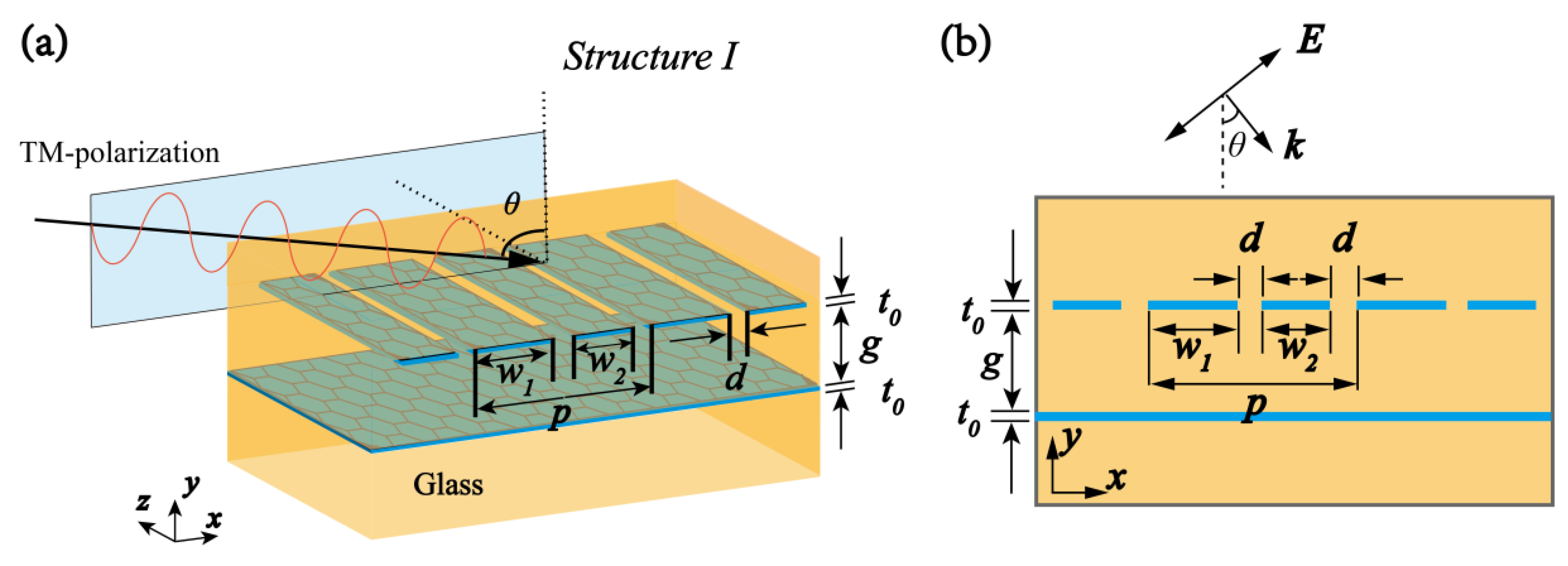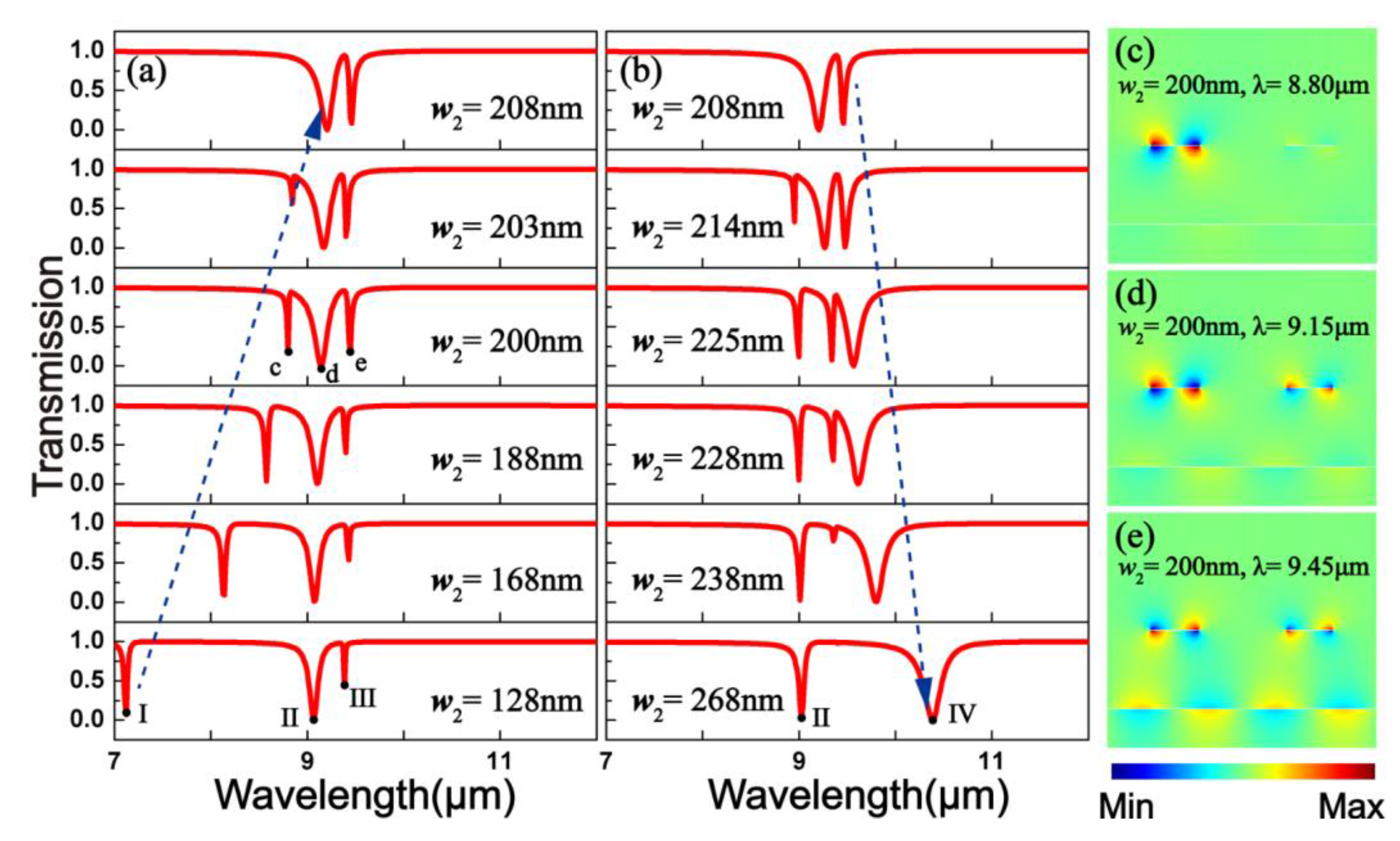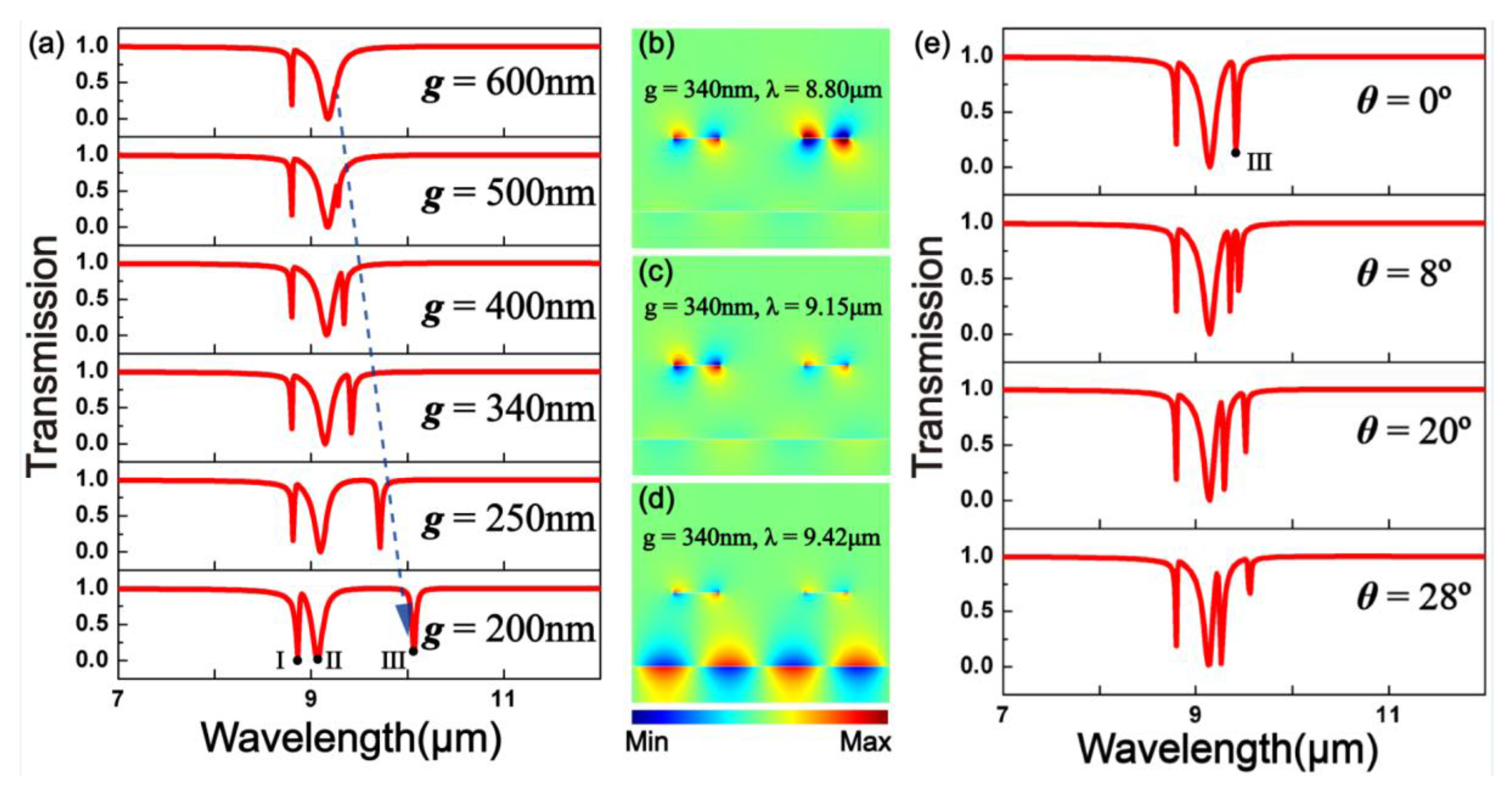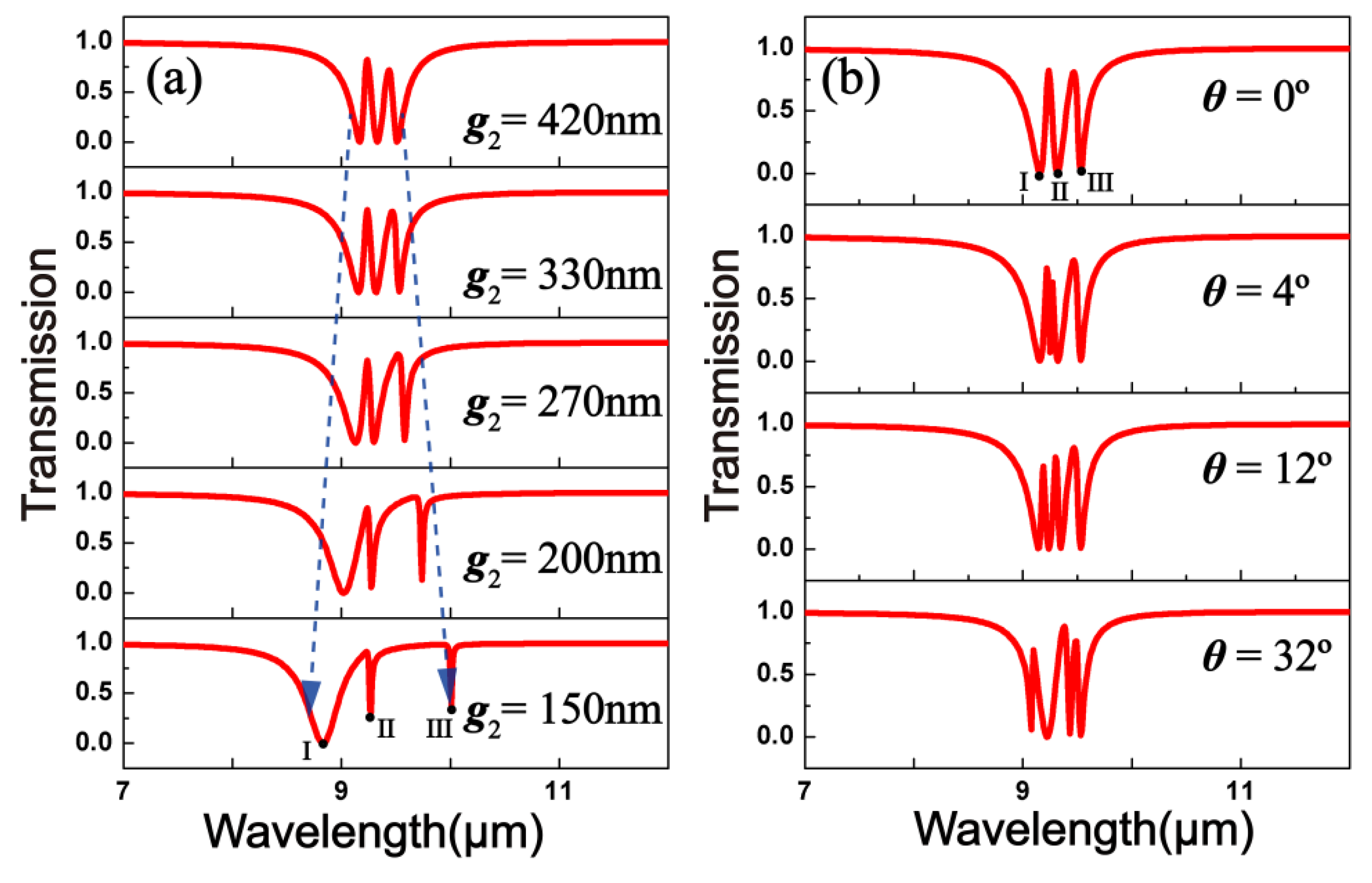Tunable Multiple Plasmon-Induced Transparencies Based on Asymmetrical Grapheme Nanoribbon Structures
Abstract
:1. Introduction
2. Materials Model and Analysis
3. Simulation and Results
4. Conclusions
Acknowledgments
Author Contributions
Conflicts of Interest
References
- Harris, S.E. Electromagnetically induced transparency. Phys. Today 1997, 50, 36–42. [Google Scholar] [CrossRef]
- Gu, J.Q.; Singh, R.; Liu, X.; Zhang, X.; Ma, Y.; Zhang, S.; Maier, S.A.; Tian, Z.; Azad, A.K.; Chen, H.-T.; et al. Active control of electromagnetically induced transparency analogue in terahertz metamaterials. Nat. Commun. 2012, 3, 1151. [Google Scholar] [CrossRef] [PubMed]
- Tassin, P.; Zhang, L.; Zhao, R.; Jain, A.; Koschny, T.; Soukoulis, C.M. Electromagnetically induced transparency and absorption in metamaterials: The radiating two-oscillator model and its experimental confirmation. Phys. Rev. Lett. 2012, 109, 187401. [Google Scholar] [CrossRef] [PubMed]
- Boller, K.J.; Imamoğlu, A.; Harris, S.E. Observation of electromagnetically induced transparency. Phys. Rev. Lett. 1991, 66, 2593–2596. [Google Scholar] [CrossRef] [PubMed]
- Fleischhauer, M.; Imamoglu, A.; Marangos, J.P. Electromagnetically induced transparency: Optics in coherent media. Rev. Mod. Phys. 2005, 77, 633–673. [Google Scholar] [CrossRef]
- Xu, Q.F.; Sandhu, S.; Povinelli, M.L.; Shakya, J.; Fan, S.; Lipson, M. Experimental realization of an on-chip all-optical analogue to electromagnetically induced transparency. Phys. Rev. Lett. 2006, 96, 123901. [Google Scholar] [CrossRef] [PubMed]
- Papasimakis, N.; Fedotov, V.A.; Zheludev, N.I.; Prosvirnin, S.L. Metamaterial analog of electromagnetically induced transparency. Phys. Rev. Lett. 2008, 101, 253903. [Google Scholar] [CrossRef] [PubMed]
- Zhang, S.; Genov, D.A.; Wang, Y.; Liu, M.; Zhang, X. Plasmon-induced transparency in metamaterials. Phys. Rev. Lett. 2008, 101, 047401. [Google Scholar] [CrossRef] [PubMed]
- Yang, X.D.; Yu, M.; Kwong, D.-L.; Wong, C.W. All-optical analog to electromagnetically induced transparency in multiple coupled photonic crystal cavities. Phys. Rev. Lett. 2009, 102, 173902. [Google Scholar] [CrossRef] [PubMed]
- Tassin, P.; Zhang, L.; Koschny, T.; Economou, E.N.; Soukoulis, C.M. Low-loss metamaterials based on classical electromagnetically induced transparency. Phys. Rev. Lett. 2009, 102, 053901. [Google Scholar] [CrossRef] [PubMed]
- Sun, Y.; Jiang, H.; Yang, Y.; Zhang, Y.; Chen, H.; Zhu, S. Electromagnetically induced transparency in metamaterials: Influence of intrinsic loss and dynamic evolution. Phys. Rev. B. 2011, 83, 195140. [Google Scholar] [CrossRef]
- Wright, A.R.; Xu, X.G.; Cao, J.C.; Zhang, C. Strong nonlinear optical response of graphene in the terahertz regime. Appl. Phys. Lett. 2009, 95, 072101. [Google Scholar] [CrossRef]
- Bolotin, K.I.; Sikes, K.J.; Jiang, Z.; Klima, M.; Fudenberg, G.; Hone, J.; Kim, P.; Stormer, H.L. Ultrahigh electron mobility in suspended graphene. Solid State Commun. 2008, 146, 351–355. [Google Scholar] [CrossRef]
- Balandin, A.A.; Ghosh, S.; Bao, W.; Calizo, I.; Teweldebrhan, D.; Miao, F.; Lau, C.N. Superior thermal conductivity of single-layer graphene. Nano Lett. 2008, 8, 902–907. [Google Scholar] [CrossRef] [PubMed]
- Bao, Q.L.; Loh, K.P. Graphene photonics, plasmonics, and broadband optoelectronic devices. ACS Nano 2012, 6, 3677–3694. [Google Scholar] [CrossRef] [PubMed]
- Grigorenko, A.N.; Polini, M.; Novoselov, K.S. Graphene plasmonics. Nat. Photonics 2012, 6, 749–758. [Google Scholar] [CrossRef]
- Wang, X.S.; Chen, C.; Pan, L.; Wang, J. A graphene-based Fabry-Pérot spectrometer in mid-infrared region. Sci. Rep. UK 2016, 6, 32616. [Google Scholar] [CrossRef] [PubMed]
- Song, C.; Xia, X.; Hu, Z.; Liang, Y.; Wang, J. Characteristics of plasmonic Bragg reflectors with graphene-based silicon grating. Nanoscale Res. Lett. 2016, 11, 419. [Google Scholar] [CrossRef] [PubMed]
- Li, Z.B.; Yao, K.; Xia, F.; Shen, S.; Tian, J.; Liu, Y. Graphene plasmonic metasurfaces to steer infrared light. Sci. Rep. UK 2015, 5, 12423. [Google Scholar] [CrossRef] [PubMed]
- Brar, V.W.; Jang, M.S.; Sherrott, M.; Lope, J.J.; Atwater, H.A. Highly confined tunable mid-infrared plasmonics in graphene nanoresonators. Nano Lett. 2013, 13, 2541–2547. [Google Scholar] [CrossRef] [PubMed]
- Yao, G.; Ling, F.; Yue, J.; Luo, C.; Luo, Q.; Yao, J. Dynamically electrically tunable broadband absorber based on graphene analog of electromagnetically induced transparency. IEEE Photonics J. 2016, 8, 1–8. [Google Scholar] [CrossRef]
- Li, Y.; Yu, H.; Dai, T.; Jiang, J.; Wang, G.; Yang, L.; Wang, W.; Yang, J.; Jiang, X. Graphene-based floating-gate nonvolatile optical switch. IEEE Photonics Technol. Lett. 2016, 28, 284–287. [Google Scholar] [CrossRef]
- Fahad, M.S.; Srivastava, A.; Sharma, A.K.; Mayberry, C. Analytical current transport modeling of graphene nanoribbon tunnel field-effect transistors for digital circuit design. IEEE Trans. Nanotechnol. 2016, 15, 39–50. [Google Scholar] [CrossRef]
- Yurchenko, S.O.; Komarov, K.A.; Pustovoit, V.I. Multilayer-graphene-based amplifier of surface acoustic waves. AIP Adv. 2015, 5, 057144. [Google Scholar] [CrossRef]
- Al-Dirini, F.; Mohammed, M.A.; Hossain, F.M.; Nirmalathas, T.; Skafidas, E. All-graphene planar double-quantum-dot resonant tunneling diodes. IEEE J. Electron Devices Soc. 2016, 4, 30–39. [Google Scholar] [CrossRef]
- Wang, X.C.; Zhao, W.S.; Hu, J.; Yin, W.Y. Reconfigurable terahertz leaky-wave antenna using graphene-based high-impedance surface. IEEE T. Nanotechnol. 2015, 14, 62–69. [Google Scholar] [CrossRef]
- Correas-Serrano, D.; Gomez-Diaz, J.S.; Perruisseau-Carrier, J.; Alvarez-Melcon, A. Graphene-based plasmonic tunable low-pass filters in the terahertz band. IEEE Trans. Nanotechnol. 2014, 13, 1145–1153. [Google Scholar] [CrossRef]
- Mao, X.; Cheng, C.; Huang, B.; Zhang, Z.; Gan, S.; Chen, H.; Chen, H. Optoelectronic mixer based on graphene FET. IEEE Electr. Device Soc. 2015, 36, 253–255. [Google Scholar] [CrossRef]
- Wang, Y.; Chen, Q.; Shen, X. Actively controlled plasmonic Bragg reflector based on a graphene parallel-plate waveguide. AIP Adv. 2015, 5, 1–7. [Google Scholar] [CrossRef]
- Shi, X.; Han, D.; Dai, Y.; Yu, Z.; Sun, Y.; Chen, H.; Liu, X.; Zi, J. Plasmonic analog of electromagnetically induced transparency in nanostructure graphene. Opt. Express 2013, 21, 28438–28443. [Google Scholar] [CrossRef] [PubMed]
- Hanson, G.W. Quasi-transverse electromagnetic modes supported by a graphene parallel-plate waveguide. J. Appl. Phys. 2008, 104, 084314. [Google Scholar] [CrossRef]
- Li, H.J.; Wang, L.L.; Sun, B.; Huang, Z.R.; Zhai, X. Controlling mid-infrared surface plasmon polaritons in the parallel graphene pair. Appl. Phys. Express 2014, 7, 125101. [Google Scholar] [CrossRef]
- Wang, L.; Li, W.; Jiang, X.Y. Tunable control of electromagnetically induced transparency analogue in a compact graphene-based waveguide. Opt. Lett. 2015, 40, 2325–2328. [Google Scholar] [CrossRef] [PubMed]
- Lin, Q.; Zhai, X.; Wang, L.; Wang, B.; Liu, G.; Xia, S. Combined theoretical analysis for plasmon-induced transparency in integrated graphene waveguides with direct and indirect couplings. EPL Europhys. Lett. 2015, 111, 34004. [Google Scholar] [CrossRef]
- Wang, B.; Zhang, X.; Yuan, X.; Teng, J. Optical coupling of surface plasmons between graphene sheets. Appl. Phys. Lett. 2012, 100, 131111. [Google Scholar] [CrossRef]
- Jablan, M.; Buljan, H.; Soljacic, M. Plasmonics in graphene at infrared frequencies. Phys. Rev. B 2009, 80, 245435. [Google Scholar] [CrossRef]
- Lu, Y.; Xu, H.; Rhee, J.Y.; Jang, W.H.; Ham, B.S.; Lee, Y. Magnetic plasmon resonance: Underlying route to plasmonic electromagnetically induced transparency in metamaterials. Phys. Rev. B 2010, 82, 195112. [Google Scholar] [CrossRef]






© 2017 by the authors. Licensee MDPI, Basel, Switzerland. This article is an open access article distributed under the terms and conditions of the Creative Commons Attribution (CC BY) license (http://creativecommons.org/licenses/by/4.0/).
Share and Cite
Lu, C.; Wang, J.; Yan, S.; Hu, Z.-D.; Zheng, G.; Yang, L. Tunable Multiple Plasmon-Induced Transparencies Based on Asymmetrical Grapheme Nanoribbon Structures. Materials 2017, 10, 699. https://doi.org/10.3390/ma10070699
Lu C, Wang J, Yan S, Hu Z-D, Zheng G, Yang L. Tunable Multiple Plasmon-Induced Transparencies Based on Asymmetrical Grapheme Nanoribbon Structures. Materials. 2017; 10(7):699. https://doi.org/10.3390/ma10070699
Chicago/Turabian StyleLu, Chunyu, Jicheng Wang, Shubin Yan, Zheng-Da Hu, Gaige Zheng, and Liu Yang. 2017. "Tunable Multiple Plasmon-Induced Transparencies Based on Asymmetrical Grapheme Nanoribbon Structures" Materials 10, no. 7: 699. https://doi.org/10.3390/ma10070699



